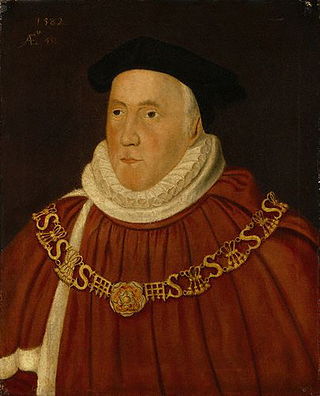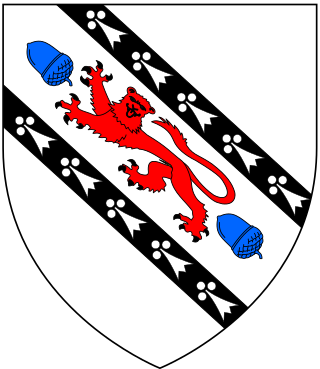Related Research Articles

George Manners, 11th Baron de Ros of Helmsley was an English peer.
Sir William Coningsby was an English Member of Parliament and a Justice of the King's Bench.
Sir Richard Newdigate, 1st Baronet was an English judge, landowner and politician who sat in the House of Commons from 1660.

Sir Christopher Wray was an English judge and Chief Justice of the King's Bench.
Sir Edward Saunders was an English judge and Chief Justice of the Queen's Bench.

Sir Francis Rodes of Barlborough Hall in the parish of Barlborough, Derbyshire, was an English judge who took part in the trial of Mary, Queen of Scots. He built Barlborough Hall and was one of the founders of Netherthorpe School.

Sir Cotton Gargrave (1540–1588) was an English landowner and politician who sat in the House of Commons in 1571 and 1572.
Sir William Hawte was a prominent member of a Kentish gentry family of long standing in royal service, which, through its near connections to the Woodville family, became closely and dangerously embroiled in the last phases of the Wars of the Roses.

Sir Francis Gawdy was an English judge. He was a Justice of the King's Bench, and Chief Justice of the Common Pleas. His country seat and estates were in Norfolk.

Sir Richard Hutton was a Yorkshire landowner, and judge. He defied Charles I over ship money.

Sir James Strangeways was Speaker of the House of Commons of England between 1461–1462. and a close political ally of Edward IV's Yorkist faction.
Sir Thomas Fairfax was an owner of Gilling Castle, near Gilling East, North Riding of Yorkshire, England.
Sir Thomas Fairfax was the first member of the Fairfax family to own Gilling Castle, near Gilling East, North Riding of Yorkshire, England.
Thomas Fairfax, 1st Viscount Fairfax of Emley JP was an English landowner and politician who sat in the House of Commons at various times between 1601 and 1626. He was created Viscount Fairfax in the Peerage of Ireland in 1629. He "erected a mansion on Bishophill (York) early in Elizabeth's reign".

Brian Palmes was an English landowner, justice of the assize and politician who sat in the House of Commons.

The Palmes family of Naburn Hall, and the cadet branches of Lindley Hall, North Yorkshire; Ashwell, Rutland; and Carcraig in Ireland, are an ancient English aristocratic family, noted for their adherence to Catholicism.

Sir William de Notton, or Norton was an English landowner and judge, who had a highly successful career in both England and Ireland, culminating in his appointment as Lord Chief Justice of Ireland in 1361.
William Skrene was an Irish-born barrister and judge who spent most of his adult life in England, where he became King's Serjeant and a judge of assize. He also served briefly as Chief Baron of the Irish Exchequer in 1395-7. He acquired substantial lands in Essex.
Sir Richard Tempest was an English landowner, courtier, soldier, administrator and legislator under Kings Henry VII and Henry VIII who was imprisoned after joining the Pilgrimage of Grace and died in jail.
Sir John Spelman was an English judge from Norfolk, noted for his composition of law reports.
References
- ↑ There are two places in Yorkshire called Walton – Walton, Leeds and Walton, Wakefield. The latter of those places was mentioned in the Domesday Book; and is the site of Walton Hall, a stately home built on the site of a former moated mediaeval hall. That is suggestive but not decisive evidence of where Thomas Fairfax lived.
- ↑ Rot. Parl. iv. 164
- ↑ (Grants of Edward V, 6)
- ↑ "Steeton Hall". Heritage Gateway. Historic England. Retrieved 18 October 2023.
![]() This article incorporates text from a publication now in the public domain : "Fairfax, Guy". Dictionary of National Biography . London: Smith, Elder & Co. 1885–1900.
This article incorporates text from a publication now in the public domain : "Fairfax, Guy". Dictionary of National Biography . London: Smith, Elder & Co. 1885–1900.